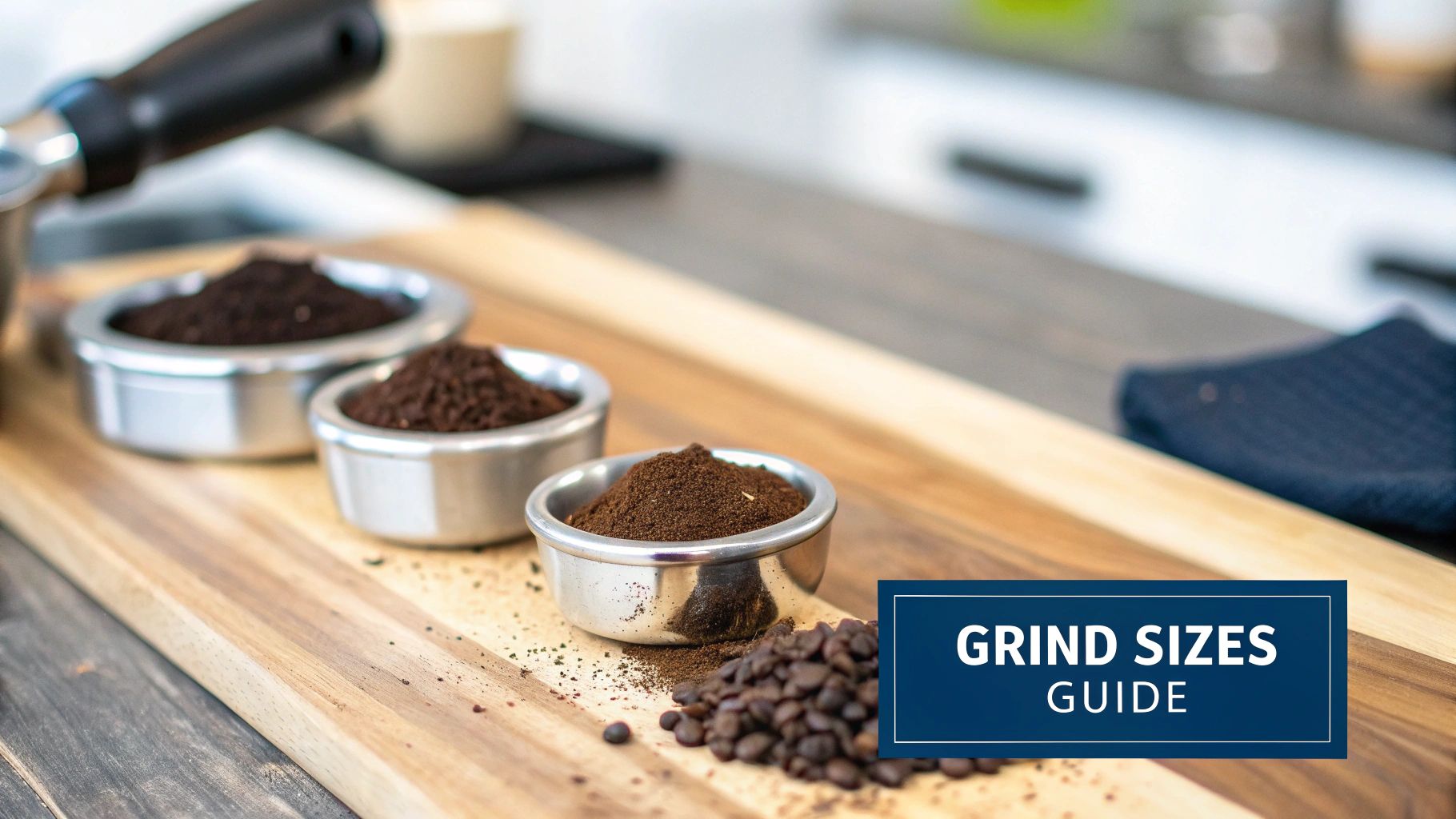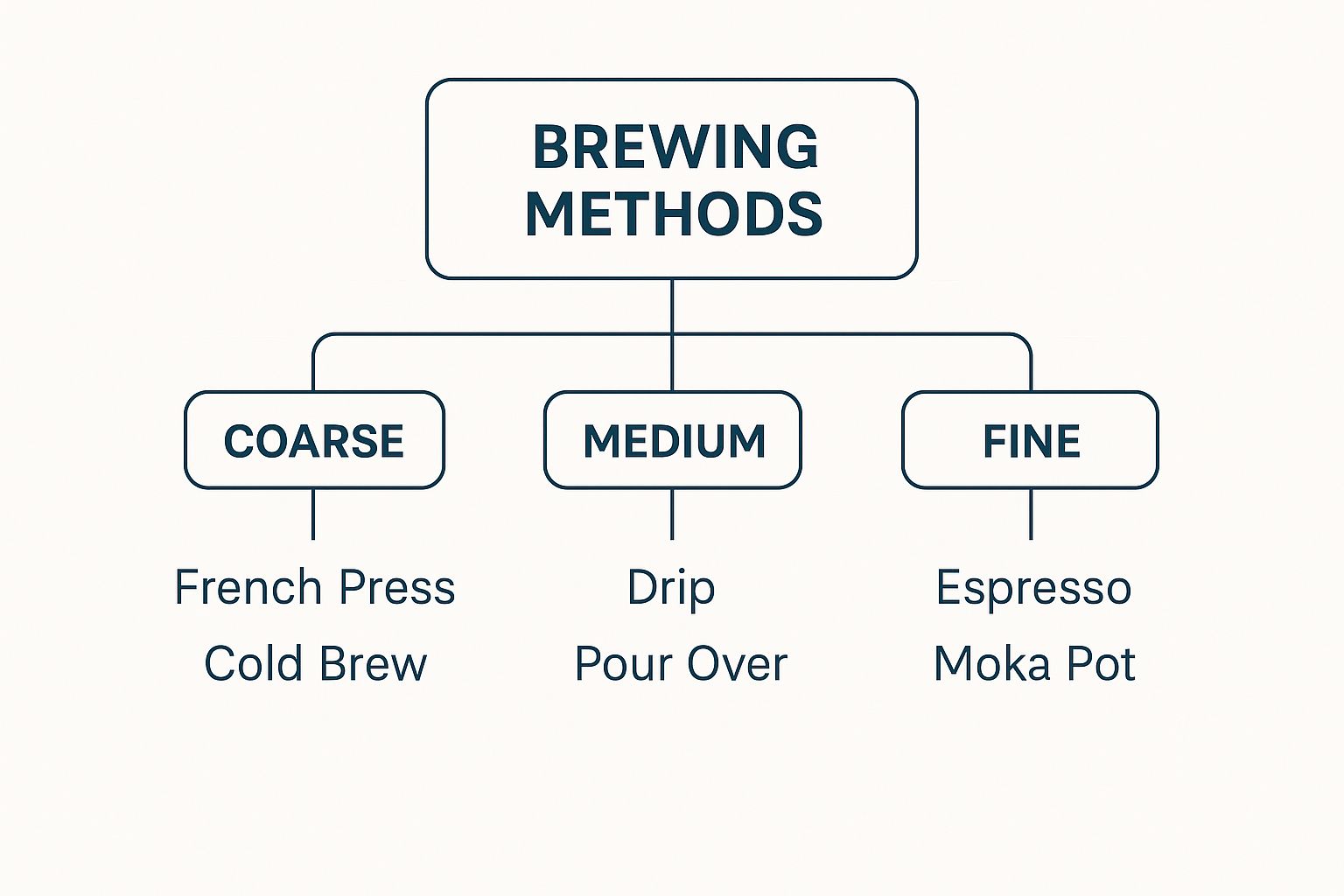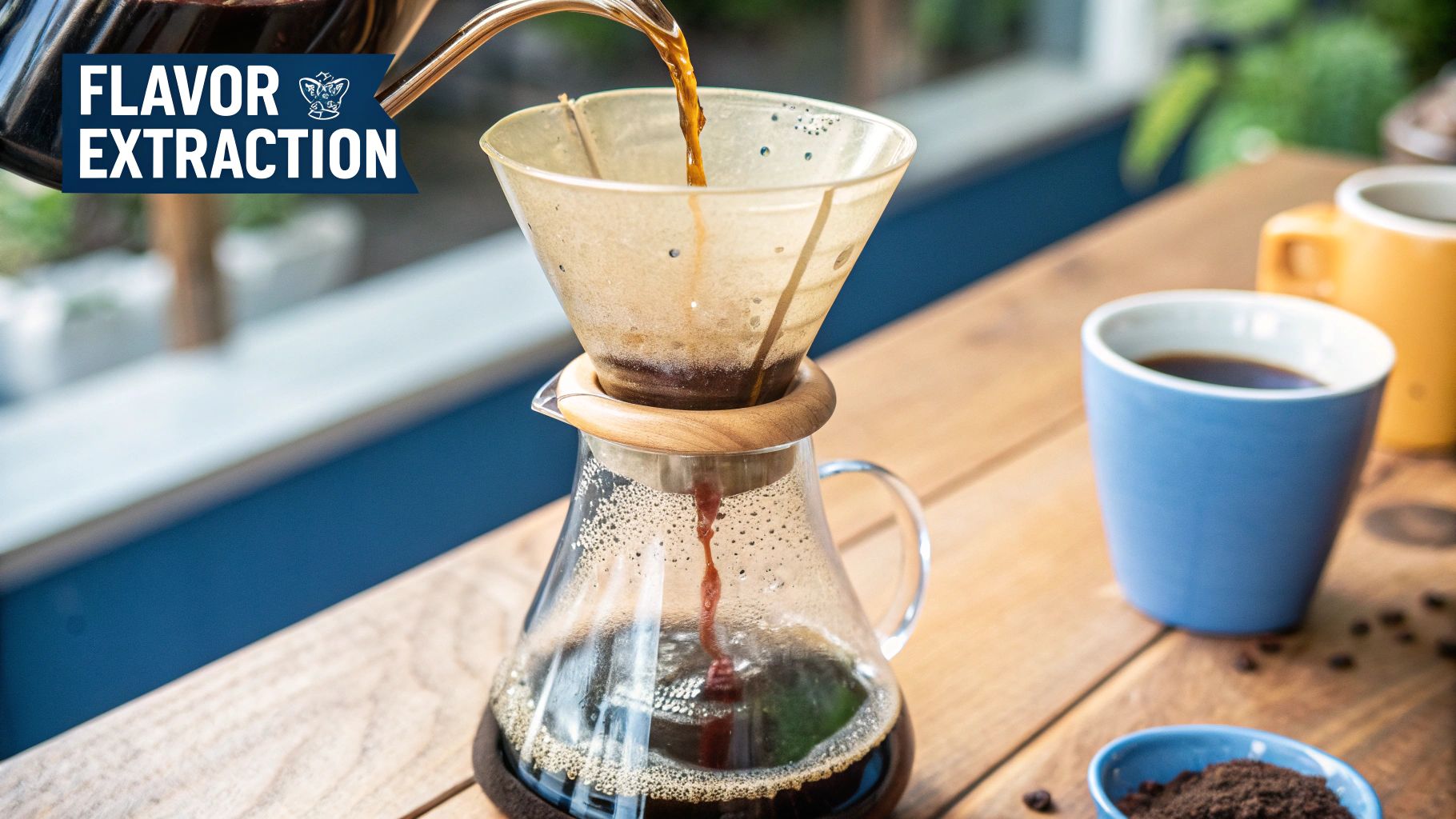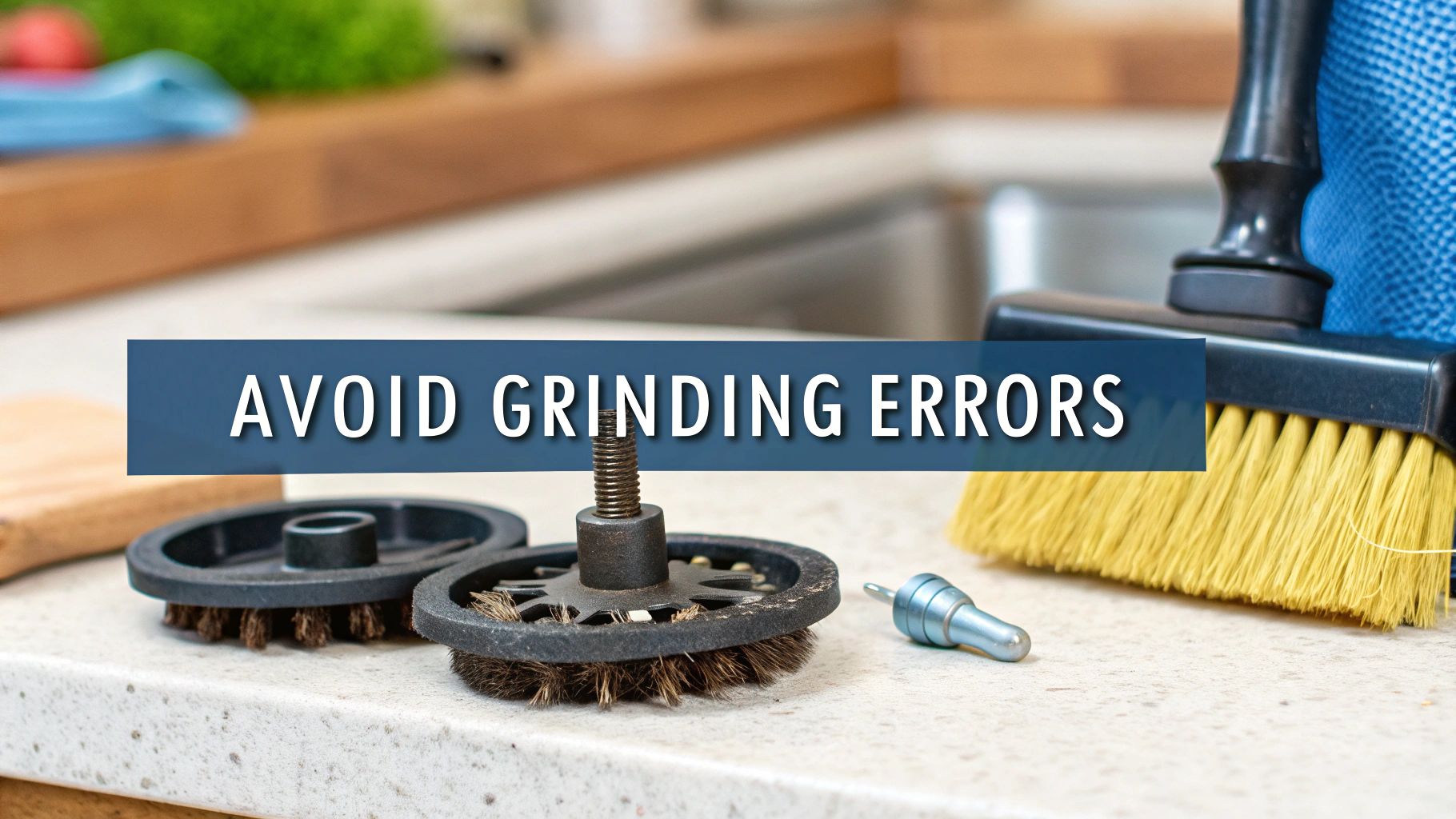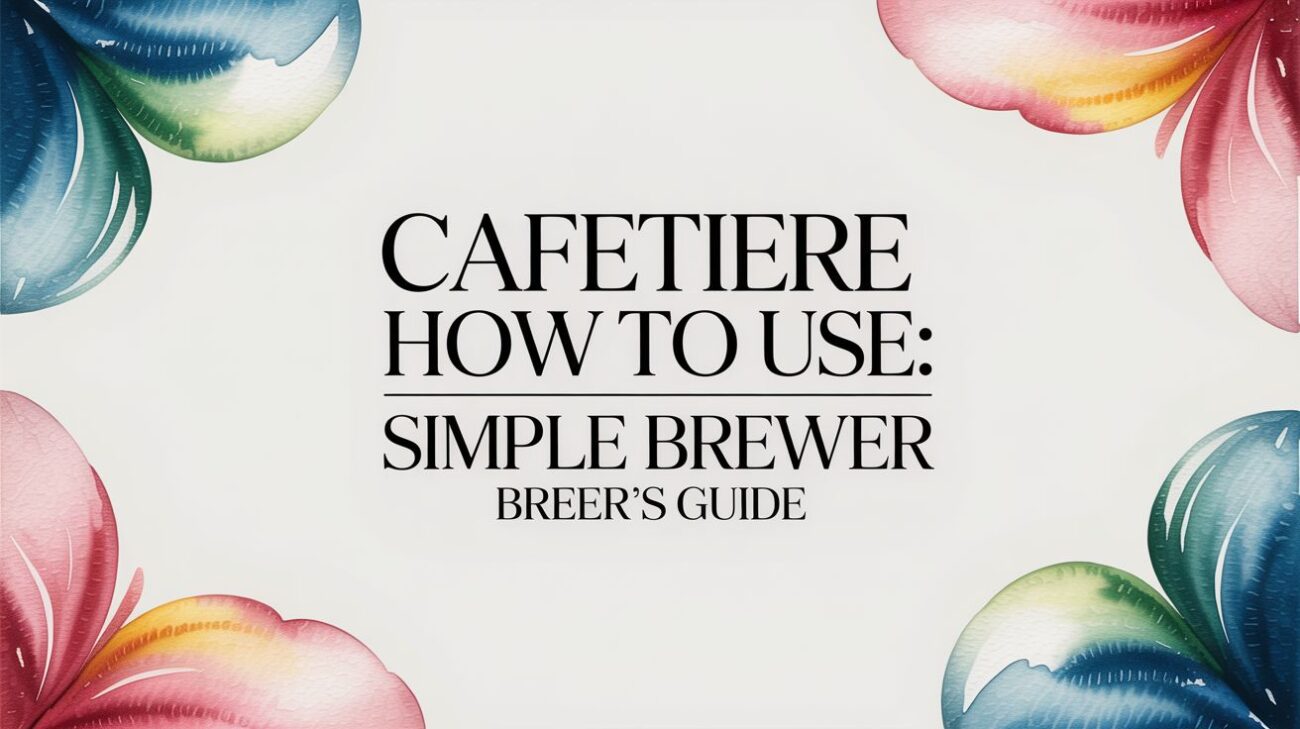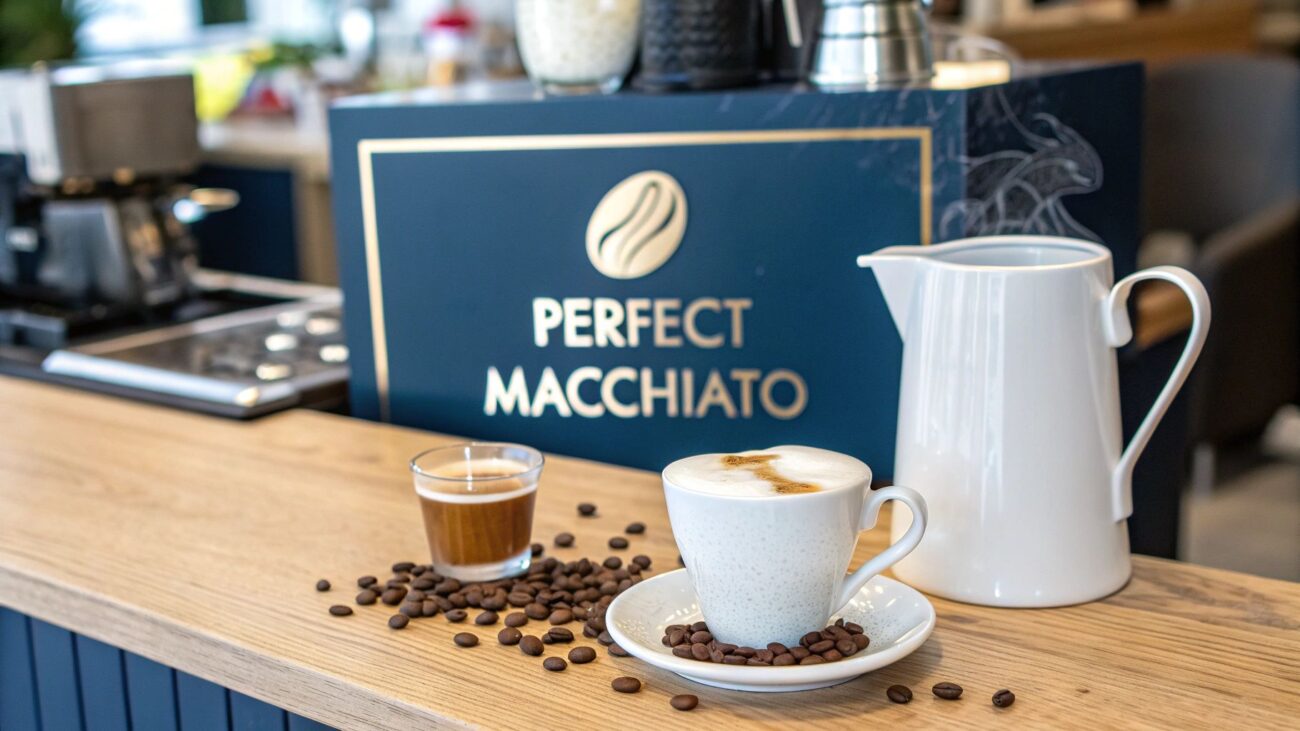Your Definitive Coffee Grind Size Guide
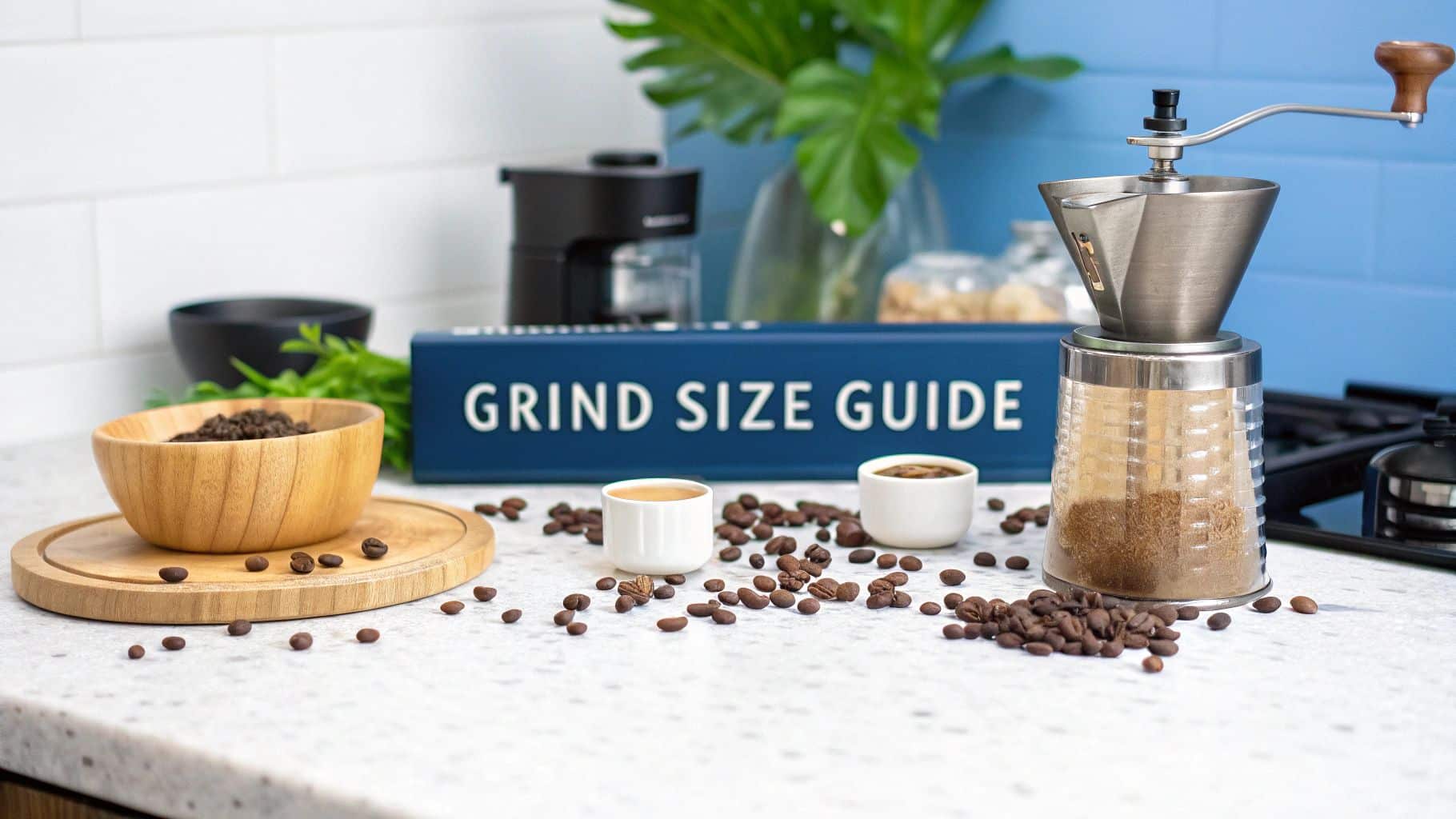
If you're serious about your coffee, a proper coffee grind size guide is your roadmap. Think of it less as a set of rules and more as the key to unlocking exceptional flavour, turning a good cup of coffee into a truly great one. Adjusting your grind is the single most powerful tool you have to control extraction, and getting it right is what guarantees a balanced, delicious brew every single time.
Why Grind Size Is Your Secret to Better Coffee
Forget fancy machines and complicated techniques for a moment. Changing how coarse or fine your coffee is ground is the most effective way to elevate your brew. It's the master control that dictates exactly how much flavour gets pulled from your beans into the water.
Let's borrow an analogy from the world of tea. If you drop a whole tea leaf into hot water, its flavour seeps out slowly and gently over several minutes. But what if you crush that same leaf into tiny specks? It infuses the water with intense flavour almost instantly. Coffee works on the exact same principle.
Surface Area and Extraction Speed
It all boils down to one core concept: surface area. Grinding your beans finer creates more tiny particles, which dramatically increases the total surface area that the hot water can touch. This massively speeds up the extraction process, pulling out all those lovely sugars, acids, and oils much more quickly.
On the flip side, a coarser grind means larger particles with less surface area. This slows the whole process right down, meaning the coffee needs a longer contact time with the water to draw out all the good stuff. Nailing this balance is the difference between a delicious cup and a disappointing one.
Mastering grind size means you are no longer leaving flavour to chance. You are actively controlling the extraction process to match your specific brewing method, whether it's a quick espresso shot or a slow, immersive French press.
The growing appreciation for this detail is clear. Here in the UK, where we now drink around 98 million cups daily, there's been a huge shift away from instant coffee towards home brewing methods that demand this kind of precision. This cultural change shows just how important it is to understand how to properly brew coffee, and it all starts with the grind.
This guide will demystify this critical variable, giving you the confidence to brew consistently delicious coffee, whatever your favourite method might be.
The Complete Spectrum of Coffee Grind Sizes
Trying to get your head around coffee grinds can feel like learning a new language, but it’s much simpler than it looks. From particles that look like chunky peppercorns to powder as fine as flour, every single texture has its own job to do. Getting to grips with these differences is the first real step to mastering your brew.
This spectrum isn’t just random; it’s all about how different brewing methods use time and water to extract flavour. A coarse grind needs a nice, long steep to give up its goods, while a fine grind only needs a few seconds under high pressure.
Let's break down the seven main grind sizes you’ll come across.
Coarse Grind Sizes
Coarse grinds are all about taking it slow. Their large particles create plenty of room for water to move around, making them perfect for immersion methods where the coffee grounds and water hang out together for a while.
-
Extra Coarse: This is the chunkiest grind you can get, looking a lot like crushed peppercorns. It’s made specifically for slow-extraction methods like cold brew, where the coffee steeps for a whopping 12-24 hours. The large size stops the final brew from getting muddy or horribly bitter during its long infusion.
-
Coarse: A little finer but still very distinct, this grind looks like coarse sea salt. It’s the classic choice for a French press. The four-minute steep time is just long enough to pull out all the delicious flavours without dragging out the harsh, bitter compounds that smaller grinds would release.
Medium Grind Sizes
This is the versatile middle ground, the home of many of the UK's favourite home brewing methods. Medium grinds hit that sweet spot, allowing for a steady, even extraction that isn't too quick or too sluggish.
-
Medium-Coarse: Think of the texture of rough sand. This grind is a go-to for brewers like the Chemex, which has a thicker filter paper that needs a slightly coarser grind to keep a decent flow rate.
-
Medium: This is your everyday benchmark grind, with a consistency similar to regular granulated sugar. It’s the standard for most automatic drip coffee makers and cone-shaped brewers like the Clever Dripper.
-
Medium-Fine: A step finer, this grind feels smoother, a bit like table salt. It puts up more of a fight against the water, making it perfect for pour-over brewers like the V60 or AeroPress. Here, a shorter brew time calls for a faster extraction. For a great visual comparison, our coffee grind size chart lays it all out.
This handy infographic quickly shows which brewing methods sit in each main grind category.
As you can see, slower methods use coarse grinds, daily brewers use medium grinds, and fast, high-pressure methods need fine grinds. It's a simple relationship, but it's everything.
Fine Grind Sizes
Fine grinds are built for speed. By creating a huge amount of surface area, they let water extract flavour almost instantly. This is essential for high-pressure brewing methods that are over and done in seconds.
-
Fine: This grind is slightly finer than table salt and is used almost exclusively for espresso machines and Moka pots. It’s dense enough to create the resistance needed to stand up to the machine's high-pressure water, which is the secret to pulling a balanced shot.
-
Extra Fine (or Turkish): The finest of them all, this texture is like powder or flour. It’s reserved for Turkish coffee, where the ultra-fine grounds are brewed right in the water and are actually consumed with the liquid, creating a uniquely thick and powerful cup.
The science is simple but crucial: solubility and extraction rate are directly controlled by grind size. Use a grind that's too coarse for espresso, and you’ll get a sour, under-extracted shot. Use a grind that's too fine in a French press, and you’ll end up with a bitter, over-extracted mess.
This simple truth has sparked a massive educational push from baristas and coffee shops everywhere. As a result, people are really starting to get it. Despite the historic popularity of instant coffee, around 16% of UK coffee buyers now choose freshly ground coffee suited to their specific brewer. It shows that nailing the grind size is the real foundation of consistently great coffee.
For a quick summary, this table maps each grind size to its texture, brewing method, and typical brew time, helping you match your beans to your brewer perfectly.
Quick Reference Coffee Grind Size Chart
| Grind Size | Visual Analogy (Texture) | Primary Brewing Methods | Recommended Brew Time |
|---|---|---|---|
| Extra Coarse | Crushed Peppercorns | Cold Brew | 12–24 Hours |
| Coarse | Coarse Sea Salt | French Press, Percolator | 4–6 Minutes |
| Medium-Coarse | Rough Sand | Chemex, Clever Dripper | 3–5 Minutes |
| Medium | Granulated Sugar | Drip Coffee Makers | 2–4 Minutes |
| Medium-Fine | Table Salt | V60, AeroPress (Pour-Over) | 2–3 Minutes |
| Fine | Fine Salt/Sugar | Espresso, Moka Pot | 20–30 Seconds |
| Extra Fine | Powdered Sugar/Flour | Turkish Coffee | 1–2 Minutes |
This chart should give you a solid starting point. Remember to experiment a little, as every coffee and every grinder is slightly different. Finding what works for you is all part of the fun.
Matching Grind Size to Your Brewing Method
Alright, let's move from theory to practice. It’s one thing to know the difference between coarse and fine, but it’s another thing entirely to know exactly which setting to use for your coffee maker. This is where you really start to master your brew.
Every brewing method is like a unique conversation between your coffee, water, and time. The grind size is the language they all speak, and getting it right is the secret to a consistently delicious cup. Think of this section of our coffee grind size guide as your go-to cheat sheet, matching the UK's favourite brewers with their perfect grind and explaining why it just works.
French Press Immersion Brewing
The French press is a classic for a reason, loved for its rich, full-bodied flavour. Because it's an immersion method, the coffee grounds and water steep together for about four minutes. That long contact time is the most important clue.
To work with this slow dance, you need a coarse grind—think of the texture of coarse sea salt. The larger particles have less surface area, which slows down extraction perfectly, stopping the coffee from becoming harsh and bitter over that four-minute steep.
There's a practical reason too. The metal mesh filter in a French press is built to hold back these bigger particles, giving you a clean cup. If you go too fine, you'll end up with a sludgy, silty mess as the tiny grounds slip straight through the filter.
Troubleshooting Tip: If your French press coffee tastes weak and watery, maybe even a bit sour, that’s a textbook sign of under-extraction. Your grind is almost certainly too coarse. Nudge your grinder one or two settings finer to give the extraction a little boost.
Pour-Over Precision with the V60
Pour-over brewers like the Hario V60 are all about control and clarity. Unlike the French press, a V60 uses a percolation method, where water passes through the coffee grounds and a paper filter. The whole show is much quicker, usually over in just two to three minutes.
This faster brew time calls for a medium-fine grind, with a consistency similar to table salt. This grind size creates just enough resistance to slow the water down for a balanced extraction. If the grind is too coarse, water will gush through, leaving you with a weak, sour cup.
On the flip side, if the grind is too fine, the water will struggle to get through the tightly packed grounds, a problem we call "stalling." This drags out the brew time and results in an over-extracted, bitter coffee. The V60 rewards precision, and hitting that medium-fine sweet spot is how you unlock its bright, clean flavour profile.
The Versatile AeroPress
The AeroPress is famous for its can-do-anything attitude, but for a standard brew, it truly shines with a medium-fine to fine grind. Because you’re manually applying pressure with the plunger, you can get away with a finer grind than you would with a typical pour-over without causing a traffic jam.
This finer grind, paired with a short steep time of around one to two minutes, produces a concentrated, espresso-like shot. It's perfect for diluting with hot water to make a delicious Americano-style coffee. Of course, you can always experiment with a medium grind for a longer, gentler immersion brew.
Moka Pot and Espresso Intensity
Both the Moka pot and the espresso machine use pressure to force hot water through a tightly packed puck of coffee. This whole process is incredibly fast—a Moka pot brew takes a few minutes, while a true espresso shot is pulled in a mere 20-30 seconds.
To get a balanced extraction in such a tiny window, you absolutely need a fine grind. We're talking about a texture slightly finer than table salt, which creates a dense coffee bed that provides the necessary resistance against the machine's pressure.
- Moka Pot: Requires a fine grind. If it’s too coarse, water will blast through too easily, giving you a weak brew. Go too fine, and you might clog the filter screen.
- Espresso: Demands an even finer, more precise grind. This is where the term "dialling in" becomes your mantra, as tiny adjustments can completely transform the flavour of your shot.
Troubleshooting Tip: Is your espresso shot gushing out in under 20 seconds and tasting sour? Your grind is too coarse. Is it choking the machine and dripping out slowly (over 35 seconds), tasting intensely bitter? Your grind is too fine. Make small, precise tweaks to find that perfect balance.
Cold Brew Patience
Cold brew flips the script entirely. Instead of using heat, it uses time—a lot of time. The coffee steeps in cold or room-temperature water for anywhere from 12 to 24 hours.
For such a long, slow extraction, you must use an extra coarse grind. The particles should look like crushed peppercorns. This massive particle size is critical to ensure the coffee extracts slowly and evenly, creating a smooth, low-acid concentrate without any of the harsh bitterness a finer grind would unleash. Trust us, making cold brew with a medium or fine grind would result in an undrinkable, muddy, and wildly over-extracted disaster.
Each of these methods offers a unique way to enjoy coffee, and as you can see, the right grind is what makes it all click. To dive deeper into these techniques, you can explore some of the best coffee brewing methods in our detailed guide and find the perfect one for your daily ritual.
Choosing the Right Coffee Grinder for You
When it comes to brewing great coffee, the right tool makes all the difference. And no tool has a bigger impact than your coffee grinder. Getting your head around the options is the final, crucial step in mastering your coffee grind. The first and most important choice you'll face is between a blade grinder and a burr grinder.
Imagine a blade grinder as a tiny food processor. It uses a spinning, propeller-like blade to violently smash coffee beans into smaller bits. The trouble is, this method creates a chaotic mess of large chunks ("boulders") and fine powder ("dust"). This unevenness leads to a poor extraction—the fine dust over-extracts and turns bitter, while the big boulders under-extract, tasting sour.
A burr grinder, on the other hand, works more like a traditional pepper mill. It channels beans between two revolving abrasive surfaces (the burrs) that crush them into a remarkably consistent and uniform size. This precision is the real secret to a balanced, delicious, and repeatable cup of coffee, ensuring every particle gives up its flavour at the same rate.
Blade Versus Burr: A Closer Look
While the low price of a blade grinder might be tempting, its inconsistency makes it a poor choice for anyone who genuinely wants to improve their coffee. The heat generated by the frantically spinning blade can also scorch your beans, negatively affecting their flavour before you even start brewing. It's a false economy.
Burr grinders are engineered for one job: producing consistent grounds. This uniformity gives you the control needed to unlock all the complex and delicate flavours hiding inside your coffee beans. For a great-tasting cup, they are the undisputed champion.
Choosing a burr grinder over a blade model is the single biggest upgrade you can make to your coffee setup. To make the choice clearer, here’s a straightforward comparison.
Blade Grinder vs Burr Grinder Comparison
| Feature | Blade Grinder | Burr Grinder |
|---|---|---|
| Grind Consistency | Highly inconsistent (dust and boulders) | Very consistent and uniform |
| Flavour Potential | Muddled, often bitter and sour | Clear, balanced, and complex |
| Price | Very affordable (£15-£30) | Higher investment (£50-£250+) |
| Best For | Grinding spices (not coffee!) | Anyone serious about good coffee |
As you can see, if flavour is your goal, a burr grinder is the only way to go. It’s an investment that pays off with every single cup.
Manual or Electric: Which Is for You?
Once you've settled on a burr grinder, your next decision is whether to go for a manual or an electric model. Each has its own benefits, catering to different lifestyles, brewing habits, and budgets.
- Manual Grinders: These hand-cranked grinders are brilliant for their portability, quiet operation, and affordability. They're perfect for brewing a cup or two at a time, making them a fantastic choice for travelling, camping, or for anyone with limited kitchen space.
- Electric Grinders: For sheer convenience and speed, nothing tops an electric grinder. They chew through larger quantities of coffee in seconds and often come with advanced features. This makes them the workhorse for daily coffee drinkers or anyone brewing for a family.
The UK's booming coffee shop scene has really raised the bar for what people expect from their daily brew. With 80% of coffee shop visitors popping in at least once a week, we've all become accustomed to the quality that comes from precise, consistent grinding. This is especially true for espresso-based drinks, which depend on a fine, uniform grind that only a quality burr grinder can deliver. You can read more about UK coffee trends on gcrmag.com.
Key Features to Consider
When you’re ready to invest in a quality grinder, there are a few key features to keep an eye on. Getting these details right can make a world of difference to your daily brewing ritual and your quest for the perfect grind. For a great selection, you can browse a wide range of coffee accessories that will complete your setup.
Here are the most important things to look for:
- Burr Material: Aim for grinders with steel or ceramic burrs. Steel burrs are celebrated for their sharpness and precision, while ceramic burrs are known for their incredible durability and for generating very little heat. You can't go wrong with either.
- Stepped vs. Stepless Adjustments: A stepped grinder clicks into a fixed number of grind settings, which makes it super easy to switch between brew methods like French press and AeroPress. A stepless grinder, however, has no clicks, offering infinite micro-adjustments. This is the gold standard for espresso lovers who need to meticulously "dial in" their shots.
Picking the right grinder is an investment in every single coffee you'll make from now on. By making a burr model your priority, you’re setting yourself up for a far more delicious and consistently brilliant brewing experience.
How to Troubleshoot Common Brewing Problems
Even with the best beans and the fanciest brewer, we all make a bad cup of coffee sometimes. It happens. But here’s the good news: the flavour in your cup is giving you direct feedback, telling you exactly what went wrong. Learning to listen to what your coffee is saying is the key to fixing it.
Most brewing issues boil down to two main culprits: under-extraction or over-extraction. Think of it like cooking. Under-extraction is like pulling a cake out of the oven too early—it's underdeveloped. Over-extraction is leaving it in too long until it's burnt and dry.
Luckily, the most powerful tool you have to fix both is your grinder. Let's decode those flavours.
Symptom: Your Coffee Tastes Sour or Weak
If your coffee hits you with a sharp, sour tang—almost like biting into an unripe lemon—that's a dead giveaway for under-extraction. The brew might also taste disappointingly thin, watery, or just hollow, lacking any real sweetness or body.
-
The Cause: Your grind is almost certainly too coarse. The water is just rushing through the large coffee particles without grabbing much flavour. Imagine pouring water over a pile of pebbles; it flows right through. The water and coffee simply didn't have enough time together.
-
The Fix: Go for a finer setting on your grinder. This increases the surface area of the coffee grounds and adds more resistance, forcing the water to slow down and extract more of the good stuff. Start small—just one or two clicks can make a world of difference.
Symptom: Your Coffee Tastes Bitter or Harsh
Ever take a sip and feel that dry, astringent sensation coat your tongue? If the coffee tastes overly intense, burnt, or just unpleasantly bitter, you've got a classic case of over-extraction. It’s the coffee equivalent of leaving a teabag in the mug for half an hour.
-
The Cause: Your grind is too fine. The tiny, tightly packed grounds are slowing the water down way too much, stretching the brew time well past its prime. This extended contact pulls out all the harsh, bitter compounds that should have been left behind.
-
The Fix: Time to back off and adjust to a coarser setting. This will let the water flow more freely, shortening the brew time and preventing those aggressive flavours from taking over your cup. Again, make a small adjustment and see how it tastes.
The goal is to land in that beautiful "sweet spot" right in the middle. A perfectly extracted coffee is balanced, with a pleasant sweetness, a gentle acidity, and a clean finish that leaves you wanting more.
The Art of Dialling In Your Grind
This whole process of making small, deliberate adjustments is what baristas call dialling in. It’s how they tune their coffee every single morning to make sure it's tasting perfect. Think of it like tuning a guitar—you make tiny tweaks until every note is in perfect harmony.
Here’s how you can do it at home:
- Isolate the Variable: To know what's working, only change one thing at a time. Keep your coffee dose, water amount, and temperature exactly the same. That way, you know any flavour change is coming from your grind adjustment.
- Brew and Taste: Make a cup and really taste it. Is it leaning sour or is it pushing into bitter territory?
- Adjust and Repeat: Based on what you taste, tweak your grinder—finer if it's sour, coarser if it's bitter. Brew another cup and compare.
- Find the Balance: Keep this up until the coffee tastes just right. Balanced, sweet, and delicious.
After a while, this becomes second nature. You'll instantly recognise the signs of a wonky extraction and know exactly which way to turn the dial on your grinder. It’s the single biggest step you can take toward making every cup a great one.
Frequently Asked Questions About Grind Size
Even after you've got the basics down, a few common questions always seem to pop up as you get more serious about your coffee. Let's tackle some of those niche issues to help you solidify your understanding and brew even better coffee at home.
Does Roast Level Affect My Grind Size?
Yes, it absolutely does. The roast level of your beans is a huge factor in how you should grind them. Think about it this way: darker roasts are more brittle and porous, meaning they give up their flavour much more easily than lighter roasts.
To avoid a harsh, bitter cup from a dark roast, you'll almost always need a slightly coarser grind than you would for a light roast, even if you're using the same brewer. It’s a small tweak that compensates for how quickly they extract.
On the flip side, light roasts are much denser and less soluble. Those beautiful, complex floral and acidic notes take a bit more coaxing to come out. A slightly finer grind is your best bet for achieving a full and balanced extraction from these beans.
Think of your grinder's dial as a flexible tool, not a fixed setting. Always be prepared to make small adjustments to suit the unique characteristics of each coffee you brew.
Can I Grind Coffee Without a Grinder?
While a quality burr grinder is always the gold standard for consistency, you're not completely out of luck if you find yourself in a bind.
Your best bet is to ask your local coffee shop or roaster to grind the beans for you when you buy them. Just be sure to tell them your brewing method (e.g., "grind this for a French press") and use the coffee as fast as you can. Pre-ground coffee loses its aroma and freshness incredibly quickly.
If you're stuck at home, you could try a blade grinder, a mortar and pestle, or even a rolling pin and a plastic bag. Just be warned: these methods will give you a very inconsistent grind, full of both large chunks and fine dust. This inevitably leads to a muddled, unbalanced flavour in your final cup.
Should I Grind All My Beans at Once?
Definitely not. This is probably one of the most common mistakes people make when brewing at home. You should always grind only the amount of coffee you need, right before you brew.
The moment you grind coffee, its surface area explodes. This massive increase exposes it to oxygen, causing it to go stale at a shocking rate. All the most fragrant and delicious compounds in coffee are volatile, which means they start escaping the second you grind.
By storing your coffee as whole beans in an airtight container and grinding on demand, you lock in those delicate flavours and guarantee a much more vibrant, delicious cup every single time.
What Does ‘Dialling In’ My Grinder Mean?
‘Dialling in’ is simply the process of finding the absolute perfect grind setting for a specific coffee on a specific brewer. It’s a calibration routine that’s most famous in the espresso world, but the principle applies to any brewing method.
You start with a recommended setting, brew a coffee, and then taste it with a critical palate.
- If your coffee tastes sour and weak, it’s under-extracted. You need to adjust your grind finer.
- If it tastes bitter and harsh, it’s over-extracted. You should adjust your grind coarser.
You just repeat this process, making small, methodical adjustments until the flavour hits that sweet spot of perfect balance. Learning how to make espresso at home is a fantastic way to get some hands-on practice with this essential skill.
At Seven Sisters Coffee Co, we believe that amazing coffee starts with freshly roasted, high-quality beans. Explore our curated selection of single-origin and blended coffees to find the perfect beans for your next brew. Discover your new favourite at https://sevensisterscoffee.co.uk.

